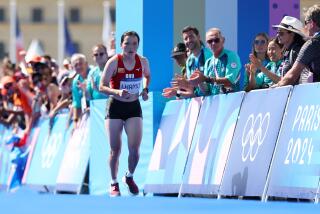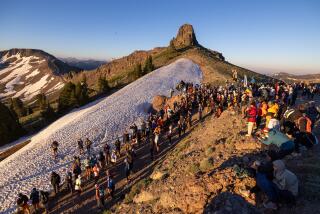A Peak U.S. Performance in Ecuador
- Share via
Climbing a 20,000-foot volcano after trudging day and night through rain forests and over high-altitude grasslands might not be your idea of a good time, but for Robyn Benincasa, the snowy summit of Cotapaxi in Ecuador was an ideal place to kick back and enjoy the view.
“Actually, it was so hard to breathe up there, I was just trying to suck up every molecule of air I could,” she says, adding that the only view she had was of one foot stepping in front of the other.
It took that much concentration simply to keep her balance. The freezing wind had peeled a layer of skin from her lip and chin. She was half-delirious. Yet she pushed on.
Cathy Sassin, on the other hand, never reached the summit of the volcano. The altitude brought on an attack of asthma and she, too, found it difficult to suck up any molecules of air. At one point she complained of seeing stars and of excruciating pain in her head.
That pain went away after the descent, but she developed a new pain after flipping her mountain bike on a rut-filled trail and separating her shoulder.
It hurt to move. Yet she continued to ride, and later she ran, at one point falling flat on her face. She picked herself up, though, and like Benincasa, she pushed on.
Only Hellfire Was Missing
Benincasa and Sassin were not lost in the Ecuadorean wilderness, nor were they being pursued by wild animals. Nor were they alone in what most people would consider a nightmare of an ordeal.
But they were the Southland’s only two entries among 245 people--making up 49 five-person teams--participating in October’s Raid Gauloises, an annual and somewhat obscure race held in exotic locations around the world over courses designed to test the endurance as well as the wills of the contestants.
The only thing missing in Ecuador was hellfire. The Raiders, as they are called, had to negotiate--using only topographical maps and compasses--an unmarked, 350-mile course through rain forests, up and over Cotapaxi, back down into the jungle, and down a rushing river that spilled out into the Pacific Ocean.
The weather ranged from stifling heat and humidity to driving rain and sub-freezing temperatures. The only assistance was offered at a handful of transition areas, where support crews exchanged gear for the various disciplines: running, climbing, mountain biking, kayaking, rafting and canoeing.
It was the ninth running of the Raid Gauloises, but what set this year’s race apart from the previous eight was its level of difficulty: Only two teams were able to complete the entire course, and those two teams were actually involved in a race, trading the lead several times practically from start to finish during nine days of hardship, er, competition.
Also unique to this year’s event was the fact that an American was on the winning team. That was Benincasa, 37, of Solana Beach. A close second was Sassin, 38, of Santa Monica.
“Navy Seals haven’t finished this race, and now you have the first American to actually win it, and not only the first American but the first American woman,” says Ric LaCivita, executive producer of the Outdoor Life Network, which will air the Raid Gauloises as a three-hour special Wednesday night at 8.
It should be pointed out that Benincasa and Sassin were placed on teams favored to win the event. Team Salomon Presidio, which pulled away in the final stages to edge Team Spie-Batignolles, had as its leader John Howard, 43, a New Zealand sheepherder who previously had won the event three times and is considered a legend among adventure racers.
Team Spie-Batignolles was led by noted French mountain guide and veteran adventure racer Eric Cassaigne.
But anyone who tunes in next week will probably agree that Benincasa and Sassin were picked to be on these teams because they are two special athletes in their own right.
Sassin, a UCLA graduate and director of the Intrafitt Center at Gold’s Gym in Venice, once toured with the American Gladiators and has now competed in five Raid Gauloises races. In August 1997 she was one of only a handful of Americans to finish the Eco-Challenge, a made-for-TV adventure race patterned somewhat after the Raid.
Benincasa, a national judo champion and a San Diego firefighter, was the captain of the 1995 Eco-Challenge team that finished second and a member of an all-woman Raid Gauloises team that finished last in 1994.
Both women say they push themselves to the limit in races like these for the intangible benefits and not for fame or fortune.
“When I get back from a race like that, nothing is really a big deal, you know?” Sassin says. “All of those little bumps and hurdles you go through over the course of a day . . . none of that stuff matters.
“There’s something so much bigger that you’re capable of. Pushing myself like that gives me a much better understanding of myself and it gives me a much better appreciation for the very simple things in life.”
Close Race Good Theater
Last week’s private screening of the “Raid Gauloises: Race Across Ecuador,” has just concluded. The production team headed by Tim Powell and Mike Sears has done an excellent job capturing the essence of the event, which is often called the toughest race on earth.
Camera crews were on the scene when tears flowed down the cheeks of a young woman overcome by pain and unable to continue, and when others fought back their tears and pushed on.
They captured for their audience the flavor of the land and the stark beauty and ruggedness of the landscape.
Luckily, though, they had a close race on their hands, which is what really makes the show work.
They stayed with the two teams basically from the beginning of the ascent of Cotapaxi until Salomon Presidio pulled away from Spie-Batignolles in the Esmeraldas River as it spilled out into the Pacific just short of the finish line.
The most compelling portion of the race was the actual ascent of the volcanic glacier, a formidable peak for even experienced mountaineers.. . .
With Sassin forbidden to continue by a doctor at one of the checkpoints, her team is assessed a four-hour penalty and loses its edge. The rest of the team continues to climb.
Later in the day, a little higher up, two members of the other team--Howard and Robert Nagle, 40, a Harvard professor--are suffering from severe altitude sickness and cannot go on. Because the team is higher up the mountain, each person is assessed only a two-hour penalty.
Benincasa, kneeling and staring into the snow, also seems about to give up, but she’s informed that at least three members of each team must reach the summit to avoid disqualification.
So she rises to her feet and slowly follows teammates Ian Adamson, 34, of Colorado, and Steve Gurney, 34, of New Zealand, to the summit, later confessing that looking up at the daunting, wind-blown peak made her think of all the people who had lost their lives on other such mountains and instilled in her a fear that almost made it impossible to take another step.
“But finally I was able to block all that out and take it one step at a time,” she says.
The view from atop Cotapaxi is spectacular, as the cameras show, affording a view that seems to span across all of Ecuador.
And only now, relaxing in her seat at the Director’s Guild of America in Hollywood, is Benincasa able to enjoy it.
“This is really the first I’ve seen of Ecuador,” she says with a smile. “It’s so hard to explain the level at which this race mentally and physically drains you. You can’t even describe the low that you’re at. Literally, it’s almost too much effort to pick up your head and look around.”
Or to suck up molecules of air.
More to Read
Sign up for Essential California
The most important California stories and recommendations in your inbox every morning.
You may occasionally receive promotional content from the Los Angeles Times.













